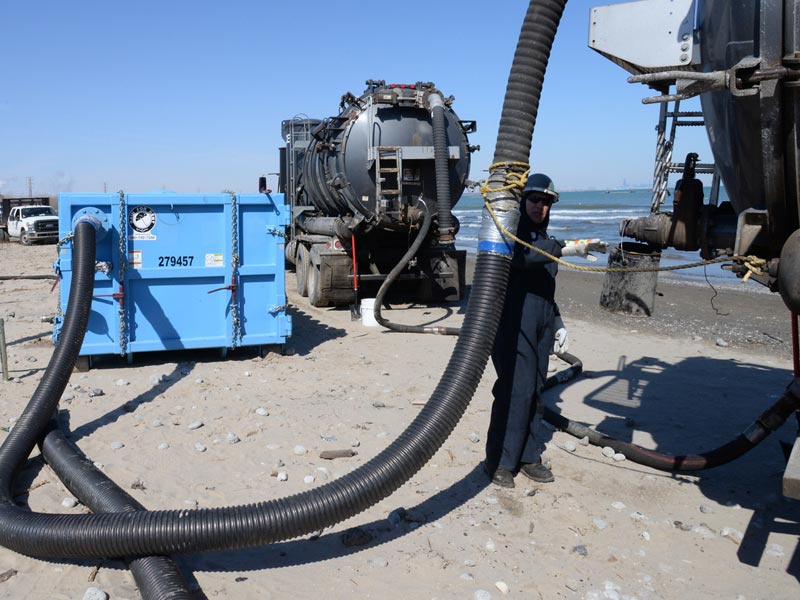Three days after spilling crude oil into Lake Michigan, BP has doubled its spill estimate to between 470 and 1228 gallons. The leak happened at its refinery in Whiting, Ind.
Although some of the oil has been cleaned up, it’s unclear how much is left in the lake, a drinking water source for about seven million Chicagoans.
Located just across the Illinois-Indiana state border, Whiting is home to the sixth largest refinery in the U.S. The refinery just went through a $4 billion “modernization project,” giving it “the capability of processing up to about 85 percent heavy crude.” That’s up from its original 20 percent, says BP‘s website.
“Frigid temperatures caused some of the oil to harden into a waxy consistency that made it easier to collect,” BP spokesman Scott Dean told The Chicago Tribune. “Crews used vacuum trucks to suck up any liquid oil that washed ashore.”
The day after the spill, U.S. Sen. Dick Durbin (D-IL) and U.S. Sen. Mark Kirk (R-IL), as well as U.S. Sen. Debbie Stabenow (D-MI) and U.S. Sen. Carl Levin (D-MI) issued press releases in which they pledged to hold BP accountable for the spill. Durbin and Kirk also wrote a follow-up letter to BP, requesting a meeting with BP.
“Any unanticipated spill is cause for concern, but given the Whiting refinery’s recent expansion of its operations to double the amount of heavy oil sands being processed, this spill raises questions about the long-term safety and reliability of BP‘s new, expanded production at Whiting,” they wrote.
Chicago Mayor (and President Obama’s former Chief-of-Staff) Rahm Emanuel had similar things to say.
“I expect a full accounting to the public,” said Emanuel. “I want a report on what happened, how it happened, why did it happen, how much happened and how do you prevent it from ever happening again.”
Though BP claims it’s “recovered the vast majority of oil that had been visible on the surface,” questions remain.
For one, what type of oil was spilled? The refinery processes tar sands bitumen, which sinks in freshwater, a point alluded to in Kirk and Durbin’s letter to BP.
Video Shows Cleanup Crew Offshore
According to a March 25 EPA press release, the “U.S. Coast Guard has flown over the area and has not observed any visible sheen.”
EPA has also deployed a “Shoreline Cleanup Assessment Team,” which consists of employees of the Coast Guard, EPA and BP. The team says it “saw minimal oiling of the shoreline and recommended a small manual removal crew conduct maintenance along the shoreline” and posted some pictures of its cleanup efforts online.

Using vacuum trucks to pick up oil; Photo Credit: U.S. EPA
The EPA‘s account has become the widely accepted one in local and national media. But a video placed on The Chicago Tribune’s website calls some of it into question.
The cleanup crew can be seen hundreds of feet offshore in Lake Michigan, with a U.S. Coast Guard helicopter flying above them. BP denies any oil is still straggling in the lake far offshore.
“It’s in the lake, yes, but it’s not moving around freely,” said Dean. “It’s been kind of contained because of the weather and of the geography of the lakefront there.”
BP has a history of playing down the size and impacts of its spills. The 2010 Gulf of Mexico mega-spill serves as Exhibit A.
As with the BP‘s Gulf of Mexico disaster, the company is running the show in Chicago, as “press calls to US EPA were routed directly to BP to answer,” according to the Natural Resources Defense Council (NRDC).
This isn’t the first time BP Whiting has been at the center of controversy.
The facility is the source of the massive mounds of petcoke currently burying portions of the southeast side of Chicago. Described by Oil Change International as the “coal hiding in the tar sands” because it can be co-burned in coal-fired power plants, until now petcoke storage was the hottest environmental issue in the Windy City.
On March 4, Illinois Attorney General Lisa Madigan filed a lawsuit against the Koch Industries subsidiary KCBX for spilling petroleum coke (“petcoke”) into Lake Michigan at its holding facility on the Calumet River, a tributary into Lake Michigan.

Petcoke spilling into the Calumet River; Photo Credit: Lloyd DeGrange
“We Still Don’t Know”
In a March 26 article about the oil spill, NRDC Midwest Program Director Henry Henderson said it’s too soon to take BP at its word about just how big or small the spill is and what its ongoing impacts may or may not be.
“[I]t’s still not clear what kind and how much oil made its way into Lake Michigan from the refinery. A day later, we still don’t know.” wrote Henderson. “The public needs to know what has made its way into their drinking water sources and whether it is being adequately cleaned.”
Photo Credit: U.S. EPA
Subscribe to our newsletter
Stay up to date with DeSmog news and alerts







